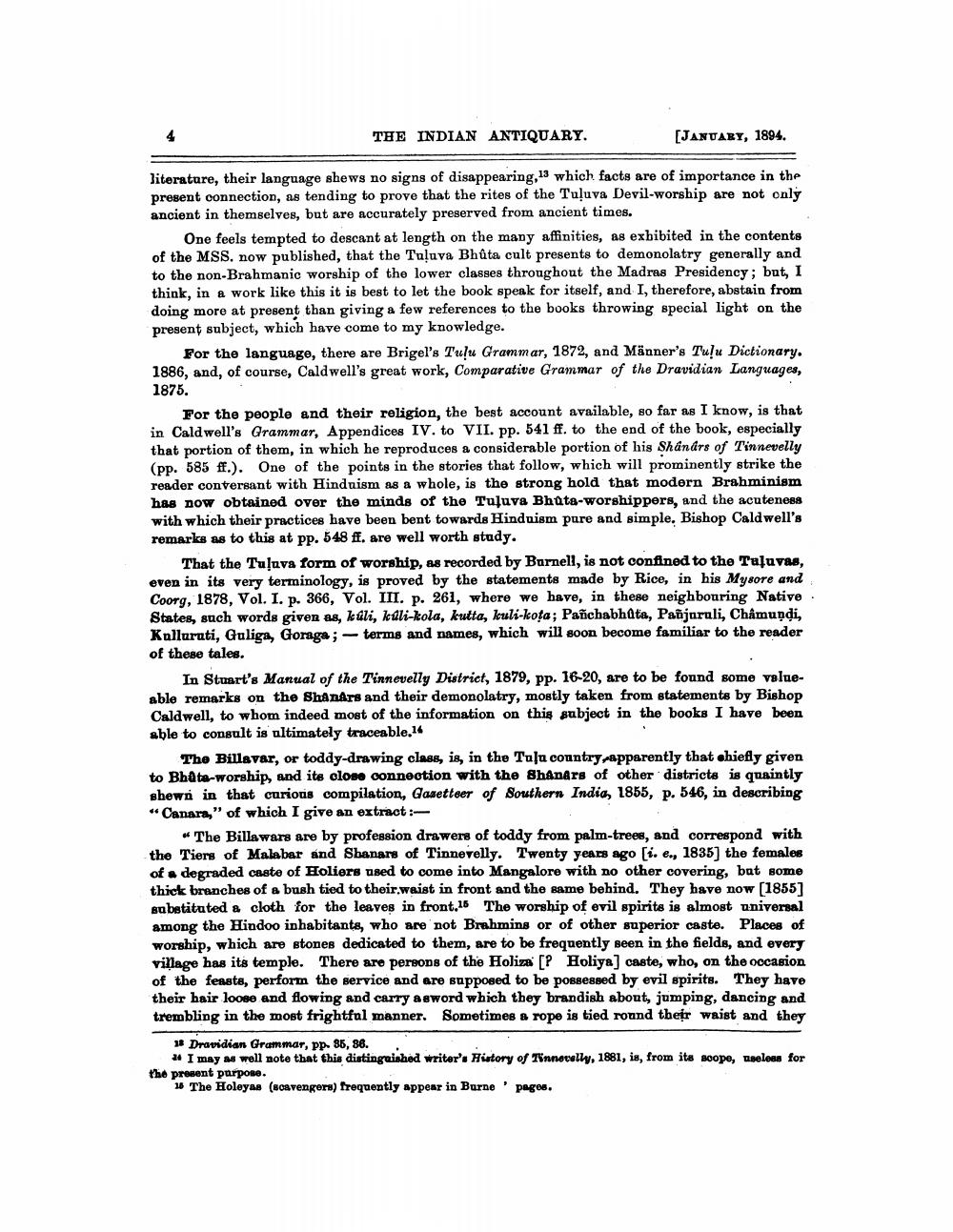Book Title: Indian Antiquary Vol 23 Author(s): Richard Carnac Temple Publisher: Swati Publications View full book textPage 8
________________ THE INDIAN ANTIQUARY. [JANUARY, 1894. literature, their language shews no signs of disappearing, 13 which facts are of importance in the present oonnection, as tending to prove that the rites of the Tuluva Devil-worship are not only ancient in themselves, but are accurately preserved from ancient times. One feels tempted to descant at length on the many affinities, as exhibited in the contents of the MSS. now published, that the Tuļuva Bhůta cult presents to demonolatry generally and to the non-Brahmanic worship of the lower classes throughout the Madras Presidency; but, I think, in a work like this it is best to let the book speak for itself, and I, therefore, abstain from doing more at present than giving a few references to the books throwing special light on the present subject, which have come to my knowledge. For the language, there are Brigel's Tulu Grammar, 1872, and Männer's Tulu Dictionary. 1886, and, of course, Caldwell's great work, Comparative Grammar of the Dravidian Languages, 1875. For the people and their religion, the best account available, so far as I know, is that in Caldwell's Grammar, Appendices IV. to VII. pp. 541 ff. to the end of the book, especially that portion of them, in which he reproduces a considerable portion of his Shandrs of Tinnevelly (pp. 585 ff.). One of the points in the stories that follow, which will prominently strike the reader conversant with Hinduism as a whole, is the strong hold that modern Brahminism has now obtained over the minds of the Tuluva Bhuta-worshippers, and the acuteness with which their practices have been bent towards Hinduism pure and simple. Bishop Caldwell's remarks as to this at pp. 548 ff. are well worth study. That the Tuluva form of worship, as recorded by Burnell, is not confined to the Tuluvas, even in its very terminology, is proved by the statements made by Rice, in his Mysore and Coorg, 1878, Vol. I. p. 366, Vol. III. p. 261, where we have, in these neighbouring Native States, such words given as, kali, kdli-kola, kutta, kuli-kota; Panchabhàta, Pañjaruli, Chamundi, Kallurati, Guliga, Goraga; - terms and names, which will soon become familiar to the reader of these tales. In Sturt's Manual of the Tinnevelly District, 1879, pp. 16-20, are to be found some valueable remarks on the ShanArs and their demonolatry, mostly taken from statements by Bishop Caldwell, to whom indeed most of the information on this subject in the books I have been able to consult is ultimately traceable.16 The Billsvar, or toddy-drawing class, is, in the Tula country apparently that chiefly given to Bhâte-worship, and its close connection with the Shandrs of other districts is quaintly shews in that curious compilation, Gazetteer of Southern India, 1855, p. 546, in describing “Canara," of which I give an extract: "The Billawars are by profession drawers of toddy from palm-trees, and correspond with the Tiers of Malabar and Shanars of Tinnevelly. Twenty years ago [i. e., 1835] the females of degraded caste of Holiers used to come into Mangalore with no other covering, but some thick branches of a bush tied to their waist in front and the same behind. They have now (1855] substituted a cloth for the leaves in front.15 The worship of evil spirits is almost universal among the Hindoo inhabitants, who are not Brahmins or of other superior caste. Places of worship, which are stones dedicated to them, are to be frequently seen in the fields, and every village has its temple. There are persons of the Holiza [P Holiya) caste, who, on the occasion of the feasts, perform the service and are supposed to be possessed by evil spirits. They have their hair loose and flowing and carry a sword which they brandish about, jumping, dancing and trembling in the most frightful manner. Sometimes a rope is tied round thetr waist and they 18 Dravidian Grammar, pp. 85, 86. I may as well note that this distinguished writer's History of Tinnotell, 1881, is, from its soopo, nelons for the present parpose. 16 The Holoyas (Boavengers) frequently appear in Burne' pagos.Page Navigation
1 ... 6 7 8 9 10 11 12 13 14 15 16 17 18 19 20 21 22 23 24 25 26 27 28 29 30 31 32 33 34 35 36 37 38 39 40 41 42 43 44 45 46 47 48 49 50 51 52 53 54 55 56 57 58 59 60 61 62 63 64 65 66 67 68 69 70 71 72 73 74 75 76 77 78 79 80 81 82 ... 412
